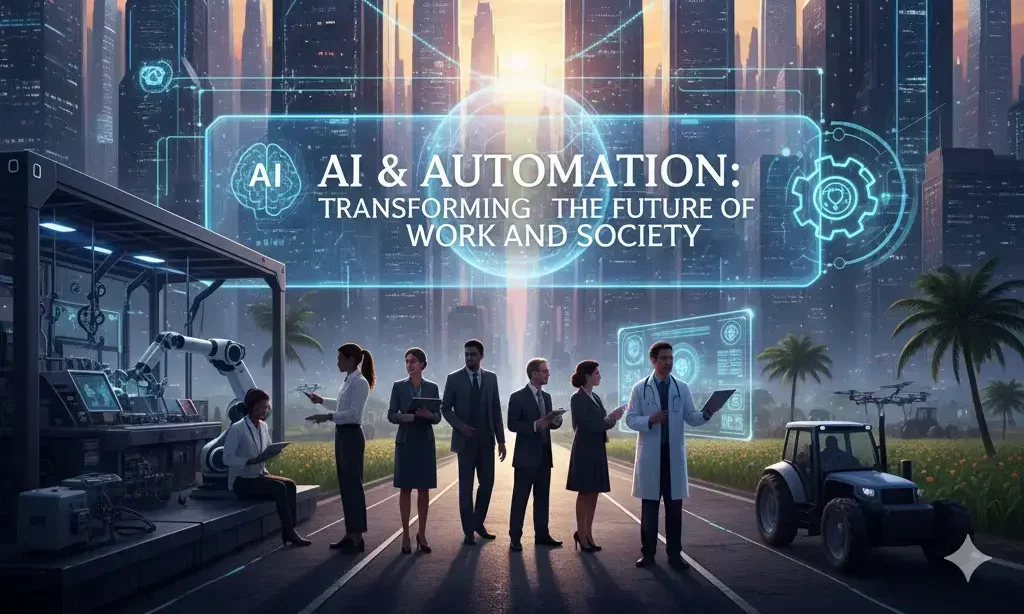AI & Automation: Transforming the Future of Work and Society
Artificial Intelligence (AI) and automation are not just buzzwords anymore—they are redefining how we live, work, and interact with technology. From self-driving cars to chatbots that mimic human conversations, these innovations are transforming industries at an unprecedented pace. As we stand at the crossroads of this technological revolution, it is important to understand what AI and automation mean, how they impact our daily lives, and what opportunities and challenges lie ahead.
What is AI and Automation?
Artificial Intelligence (AI) refers to computer systems designed to perform tasks that typically require human intelligence, such as learning, reasoning, problem-solving, and natural language understanding. Machine learning and deep learning are subsets of AI that enable systems to improve over time through data exposure.
Automation, on the other hand, is the use of technology to perform repetitive tasks without human intervention. While automation has existed for decades in manufacturing and assembly lines, the integration of AI has taken it to a whole new level. Today, AI-powered automation can not only execute tasks but also make intelligent decisions based on real-time data.
The Rise of AI-Powered Automation
The last decade has witnessed exponential growth in AI adoption across multiple sectors:
- Manufacturing – Smart robots now assemble products, predict equipment failures, and optimize supply chains.
- Healthcare – AI-powered diagnostic tools can detect diseases from scans faster than human doctors.
- Finance – Automated trading algorithms and fraud detection systems are becoming standard.
- Customer Service – Chatbots and virtual assistants like ChatGPT, Alexa, and Siri streamline customer interactions.
- Retail – AI-driven recommendation engines personalize shopping experiences.
This growth is fueled by advancements in data analytics, computing power, and cloud technologies. Companies are realizing that AI-driven automation not only reduces costs but also improves efficiency and decision-making.
Benefits of AI & Automation
The integration of AI and automation offers several compelling benefits:
- Efficiency and Productivity
AI can handle repetitive tasks at scale, freeing humans to focus on higher-value activities such as creativity, innovation, and strategy. - Cost Savings
Businesses reduce labor costs, minimize errors, and improve overall operational efficiency. - Enhanced Accuracy
AI-driven systems can analyze massive datasets with precision, leading to better predictions and outcomes. - 24/7 Availability
Unlike humans, AI systems do not need breaks, ensuring continuous operation. - Personalization
From personalized healthcare recommendations to curated online shopping experiences, AI tailors services to individual preferences.
Challenges and Risks
Despite the opportunities, AI and automation come with significant challenges:
- Job Displacement
As machines and software take over repetitive tasks, concerns about unemployment rise. While new roles will emerge, many workers may struggle to adapt. - Bias and Ethics
AI systems learn from data. If that data is biased, the AI’s decisions will also be biased. This raises ethical questions in areas like hiring, lending, and law enforcement. - Security Risks
Automated systems are vulnerable to cyberattacks. Hackers could exploit AI systems, leading to large-scale damage. - Over-reliance on Technology
Excessive dependence on AI could reduce human critical thinking and problem-solving skills. - Regulatory and Legal Issues
Governments are still catching up with policies to regulate AI development, data privacy, and accountability.
The Future of Work in the Age of AI
One of the most debated aspects of AI and automation is their impact on jobs. Studies suggest that while some jobs will disappear, others will be created. For example, routine jobs like data entry and assembly line work may vanish, but new roles in AI development, robotics, data science, and AI ethics will emerge.
A report by the World Economic Forum predicts that by 2030, automation may displace 85 million jobs worldwide but also create 97 million new ones. The key lies in reskilling and upskilling the workforce. Education systems and businesses must prepare workers for jobs that demand creativity, critical thinking, and technological literacy.
Real-World Applications
Let’s look at some examples where AI and automation are already making an impact:
- Tesla and Self-Driving Cars – Advanced AI algorithms enable vehicles to navigate without human input, although regulation and safety remain hurdles.
- Amazon’s Warehouses – Robots work alongside humans to optimize logistics and delivery efficiency.
- Healthcare Diagnostics – Tools like IBM Watson assist doctors in diagnosing complex diseases and suggesting treatments.
- Content Creation – AI systems generate news articles, reports, and even music, blurring the line between human and machine creativity.
AI & Automation in Society
Beyond the workplace, AI is shaping society in multiple ways:
- Smart Cities – AI manages traffic flow, reduces energy consumption, and enhances public safety.
- Education – Adaptive learning platforms personalize student education.
- Entertainment – Streaming services use AI to recommend shows, while gaming companies create more immersive experiences.
- Environment – AI models predict climate changes, optimize renewable energy use, and track deforestation.
Preparing for the AI-Driven Future
To harness the potential of AI while minimizing risks, societies must adopt a balanced approach:
- Reskill and Educate – Governments and businesses must invest in education and training to prepare the workforce for AI-driven roles.
- Ethical AI Development – Transparency, fairness, and inclusivity must guide AI system design.
- Stronger Regulations – Clear policies should address data privacy, AI accountability, and cybersecurity.
- Human-AI Collaboration – Instead of viewing AI as a replacement, humans should focus on synergy, where AI assists human decision-making.
Conclusion
AI and automation are transforming industries, creating opportunities, and reshaping how humans interact with technology. While challenges such as job displacement, bias, and ethical concerns remain, the potential benefits are immense. The future will not be defined by machines replacing humans but by how effectively humans and machines collaborate. As society adapts, embracing AI responsibly could lead to a world that is more efficient, innovative, and equitable.
